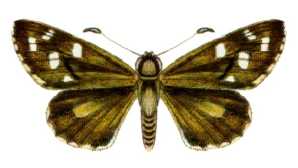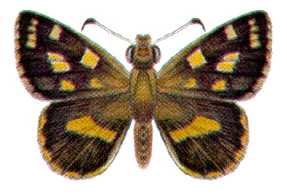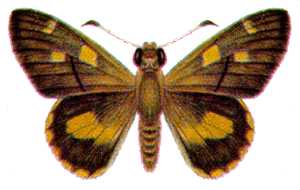
Kretzschmaria deusta, commonly known as brittle cinder, is a fungus and plant pathogen found in temperate regions of the Northern Hemisphere on broad-leaved trees, also found in Argentina, South Africa, and Australia.

Gahnia is a genus of sedges native to China, Southeast Asia, New Guinea, Australia, New Zealand and a number of Pacific Islands. The common name is due to the toothed margins. It often forms tussocks.

Gahnia filum, the chaffy saw-sedge, is a tussock-forming perennial in the family Cyperaceae, endemic to Australia. It grows to between 60 and 110 cm in height.

Gahnia trifida, the coastal saw-sedge, is a tussock-forming perennial in the family Cyperaceae, endemic to southern Australia.

Antipodia atralba, the black and white skipper, is a species of butterfly of the family Hesperiidae. It is found in Australia along the coast of Victoria and South Australia.

Antipodia chaostola, the chaostola skipper, is a species of butterfly of the family Hesperiidae. It is found in Australia along the coast of Victoria, New South Wales and Tasmania.

Tisiphone helena, the Helena brown or northern sword-grass brown, is a nymphalid butterfly. It is endemic to tropical northern Queensland.

Hesperilla chrysotricha, also known as the chrysotricha skipper or goldenhaired sedge-skipper, is a species of butterfly in the family Hesperiidae. It is found in the Australian states of Victoria, Tasmania, South Australia and Western Australia.

Hesperilla crypsargyra, also known as the silvered skipper or silver hedge-skipper, is a species of butterfly in the family Hesperiidae. It is found in the Australian states of New South Wales, Queensland and Victoria.

Hesperilla flavescens, also known as the yellow sedge-skipper or yellowish skipper, is a species of butterfly in the family Hesperiidae. It is found in the Australian states of South Australia and Victoria.

Hesperilla donnysa, also known as the donnysa skipper or varied sedge skipper, is a species of butterfly in the family Hesperiidae. It is found in the Australian Capital Territory, New South Wales, Queensland, South Australia, Tasmania, Victoria and Western Australia.

Hesperilla idothea, commonly known as the flame sedge-skipper, is a species of butterfly in the family Hesperiidae. It is found in the Australian states of New South Wales, Queensland, South Australia and Victoria.

Hesperilla ornata, also known as the spotted skipper or spotted sedge-skipper, is a species of butterfly in the family Hesperiidae. It is found along the non-tropical eastern seaboard of mainland Australia and in the adjacent mountain ranges.

Hesperilla mastersi, also known as the chequered sedge-skipper or Master's skipper, is a species of butterfly in the family Hesperiidae. It is found in the Australian states of New South Wales, Queensland and Victoria. It was also found in Tasmania, but the small area where its food plant was growing was cleared to provide cattle pasture. It is probably now extinct in Tasmania.

Gahnia grandis is a tussock-forming perennial plant found in southeastern mainland Australia and Tasmania.
Elachista deusta is a moth of the family Elachistidae. It is found in Australia.
Lake Hawdon South Conservation Park is a protected area located in the Australian state of South Australia in the locality of Bray about 280 kilometres (170 mi) south-east of the state capital of Adelaide and about 18 kilometres (11 mi) east of the town of Robe.

Ptilothrix deusta is a sedge in the family Cyperaceae found in south eastern Australia. It is commonly seen in wet sandy soils in heathland, growing from 30 to 60 cm tall. This is one of the many plants first published by Robert Brown with the type known as "(J.) v.v." appearing in his Prodromus Florae Novae Hollandiae et Insulae Van Diemen in 1810 as Carpha deusta. It was transferred to the genus, Ptilothrix, in 1994 by Karen Wilson. The genus name is derived from ancient Greek, meaning feather hair. The specific epithet deusta is derived from the Latin with a meaning of burnt.
Gahnia ancistrophylla, also known as hooked-leaf saw sedge, is a tussock-forming perennial in the family Cyperaceae, that is native to southern parts of Western Australia, South Australia and Victoria.

Gahnia decomposita is a tussock-forming perennial in the family Cyperaceae, that is native to southern parts of Western Australia.
















